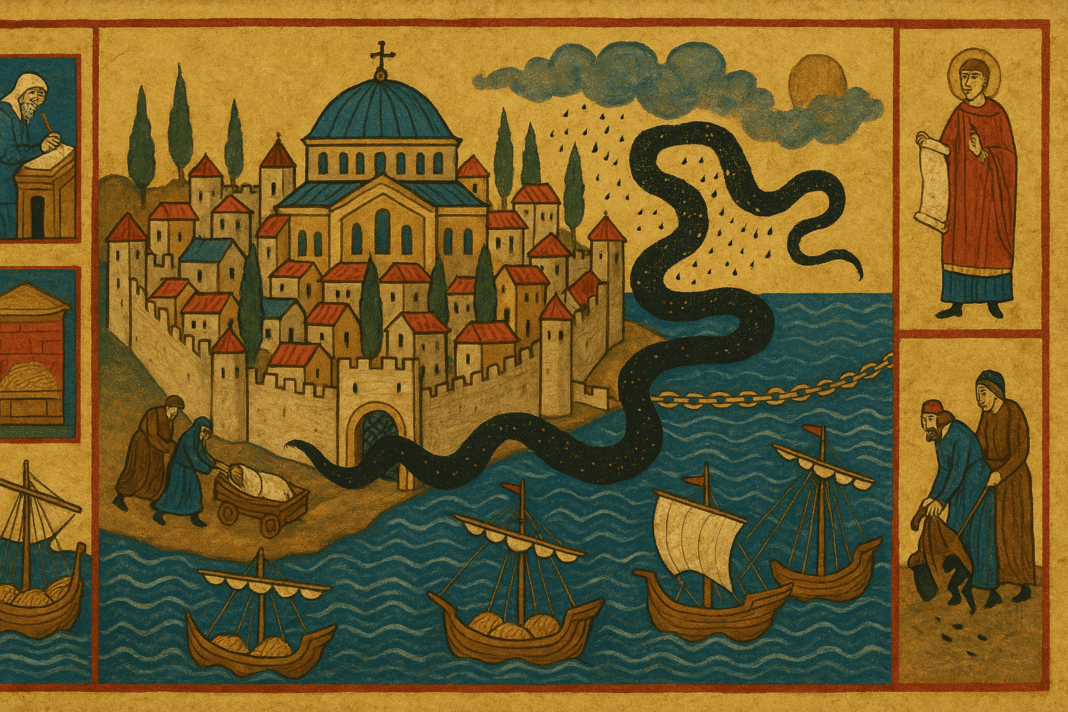
The Plague of Justinian, or Justinianic plague, was the pandemic that nearly unraveled the Byzantine empire just as it was remaking the Mediterranean. In 541 AD, it surfaced on Egypt’s coast and, by the spring of 542, it was tearing through Constantinople, where contemporary observers spoke of thousands dying each day and of the Byzantine state buckling under the weight of death.
Modern science has since identified the pathogen as Yersinia pestis, the same bacterium responsible for the Black Death, turning the horrors described by sixth-century observers into biological reality.
How the plague of Justinian began
The outbreak began in Pelusium in 541 and spread along the empire’s sea-lanes until it reached the capital. Constantinople’s dependence on Egyptian grain created ideal conditions for a fast-moving contagion, whether via commingled rodent reservoirs or human ectoparasites that ferried infection between people. Ancient DNA now leaves little doubt about the culprit, while historians and epidemiologists still debate whether rats or human-borne fleas and lice drove transmission.
Crucially, the disease arrived on the heels of the so-called Late Antique Little Ice Age, a run of severe volcanic-forced cooling after 536 that brought harvest failures and scarcity, sharpening the city’s vulnerability as the pathogen found hungry hosts in crowded cities.
The Byzantine empire, meanwhile, was at full stretch. Laws were pouring from the palace, Hagia Sophia had risen from the ashes of revolt, and armies under Belisarius and Narses were fighting on multiple fronts to save the Empire from external threats. The plague cut across this, halting recruitment, supply, and tax collection just as the empire pressed its advantage in Italy and beyond.
Scholars differ on the ultimate scale of damage, but there is broad agreement that the pandemic struck during a politically delicate moment and repeatedly returned into the eighth century, ensuring disruption long after the first terrifying wave.

The Byzantine plague in the words of witnesses
The historian Procopius painted a city where funerals halted, burial grounds overflowed, and civic life crumbled under a relentless toll of unexpected death. His near-Thucydidean remarks are joined by the Syriac bishop John of Ephesus, whose stark arithmetic conveys the speed of loss: “5,000 and 7,000, or even 12,000 and as many as 16,000 of them departed in a single day.”
Even allowing for rhetorical inflation rather than scientific precision, these voices capture a Byzantine Empire overwhelmed by plague, as officials dug pits, crammed towers with quicklime-covered corpses, and pushed burning hulks out to sea to clear the dead.
Archaeology and genetics have since extended those stories far beyond the Bosporus. Genomes from the first pandemic have been recovered from burials across Western Eurasia, tracing a pathogen lineage that flared repeatedly and moved with people, goods, and armies. The resulting map is messy, revealing a disease that spread from Ravenna to Alexandria and from Rhineland hamlets to port districts on the Golden Horn.
For over a century, historians told a “maximalist” story in which the pandemic of Justinian killed a quarter to a half of the Byzantine population and helped end Antiquity, giving way to the early Middle Ages. However, recent studies provide a different story: pollen data, mortuary archaeology, and documents in some regions suggest more uneven demographic shifts, with strong local variation rather than a uniform collapse across the Byzantine Empire—something that makes sense when the limited means of transportation at the time are considered.
Price series from Egyptian papyri, for instance, show complex post-plague economic patterns rather than a single trajectory of collapse followed by sharp recovery. What both camps share is a recognition that disease collided with climate swings, war, and policy choices to produce widely varied outcomes across the late ancient world.
The Byzantine state wrestled with questions strikingly familiar to those faced during the early 2020s global pandemic—keeping food moving when supply chains seized, ensuring the dead were buried with dignity when systems failed, legislating amid fear without corroding social trust, and sustaining campaigns abroad despite faltering recruitment at home.
Some now argue that humans themselves—carrying fleas and lice—may have been the main vectors. Others stress the role of climate-driven scarcity in priming societies for contagion. In both views, the Byzantine Empire was not brought to its knees by microbes alone but by a complex interplay of environmental, social, and political forces.
In the end, the Byzantine Empire survived but changed profoundly, with far-reaching implications. The eastern empire refocused on more defensible territories, the western reconquests weakened, and this shift effectively paved the way for more efficient Hellenization of the Eastern Roman Empire and for the eventual rift between the Orthodox East and Catholic West.


